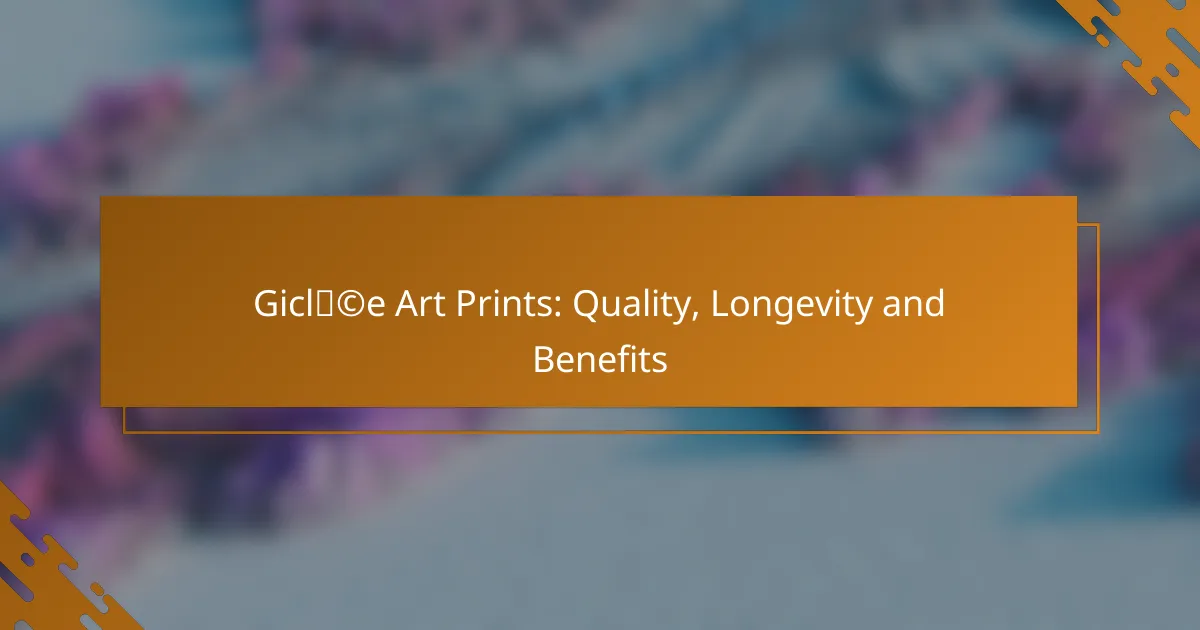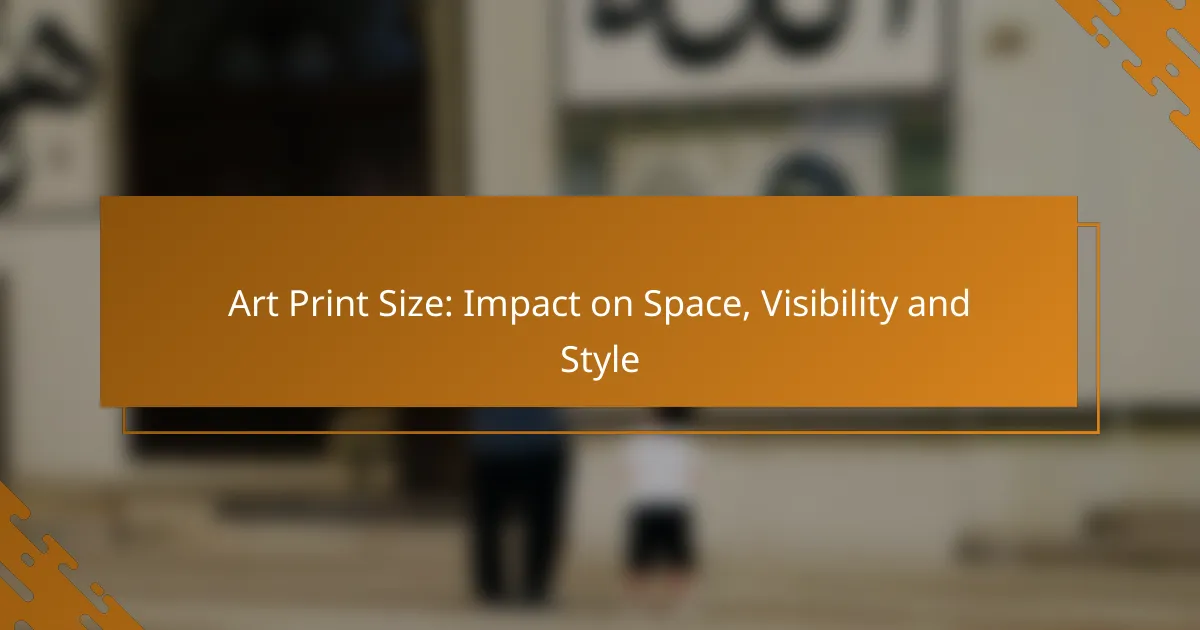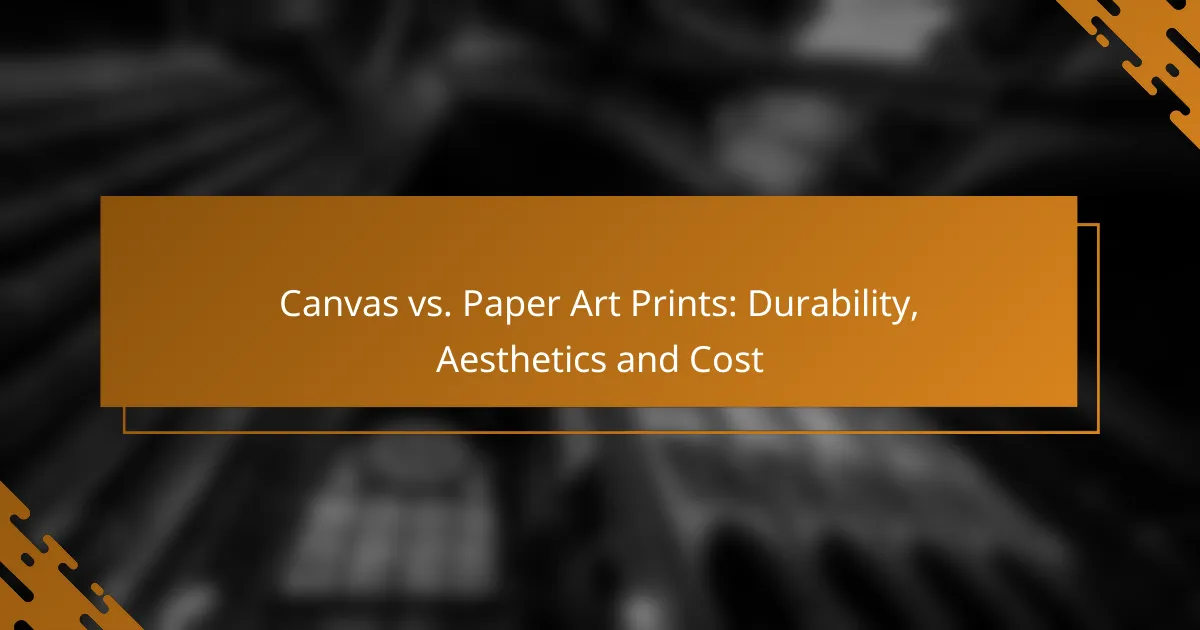Giclée art prints are premium reproductions produced with cutting-edge inkjet technology, renowned for their remarkable detail and color fidelity. These prints not only provide exceptional quality but also boast impressive durability, making them a favored option for both artists and collectors seeking lasting artwork.
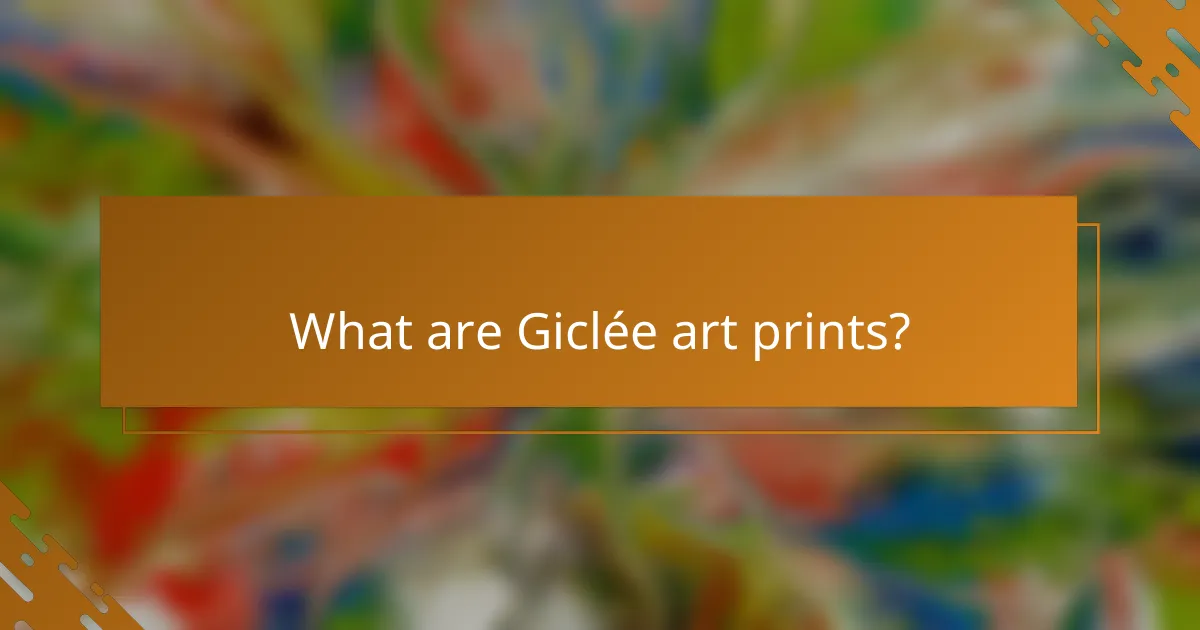
What are Giclée art prints?
Giclée art prints are high-quality reproductions created using advanced inkjet printing technology. They are known for their exceptional detail and color accuracy, making them a popular choice for artists and collectors alike.
High-quality reproduction method
The giclée printing process utilizes high-resolution digital files to produce prints that closely resemble the original artwork. This method allows for a wide color gamut and fine detail, ensuring that the nuances of the original piece are preserved. Unlike traditional printing methods, giclée prints can be produced in small batches or even as single copies.
Artists can choose from various media, including canvas and fine art paper, to achieve the desired look and feel. This flexibility makes giclée prints suitable for a range of artistic styles and preferences.
Uses archival inks and paper
Giclée prints are created using archival-quality inks that are designed to resist fading and deterioration over time. These inks are often pigment-based, which provides superior longevity compared to dye-based inks. When paired with acid-free, archival paper or canvas, giclée prints can last for decades without significant loss of color or quality.
To ensure the best results, artists and collectors should look for prints that meet industry standards for archival quality, such as those certified by the Fine Art Trade Guild or similar organizations.
Popular among artists and collectors
Giclée art prints have gained popularity among both artists and collectors due to their affordability and accessibility. Artists can produce limited editions of their work without the high costs associated with traditional printing methods. This allows them to reach a broader audience while maintaining the integrity of their original pieces.
Collectors appreciate giclée prints for their quality and the ability to own reproductions of their favorite artworks. Many collectors seek out limited edition giclée prints, which can increase in value over time, making them a worthwhile investment.

What are the benefits of Giclée art prints?
Giclée art prints offer numerous advantages, including exceptional color accuracy, long-lasting durability, and a wide range of sizes and formats. These benefits make them a preferred choice for artists and collectors alike, ensuring high-quality reproductions that stand the test of time.
Exceptional color accuracy
Giclée prints are known for their remarkable color fidelity, which is achieved through advanced inkjet printing technology. This process uses archival-quality inks that can reproduce a vast spectrum of colors, closely matching the original artwork.
Artists often choose Giclée printing because it captures subtle details and gradients that other printing methods may miss. This level of precision allows for vibrant and true-to-life reproductions that enhance the visual appeal of the artwork.
Long-lasting durability
One of the key benefits of Giclée prints is their longevity. When printed on high-quality, acid-free paper or canvas and using archival inks, these prints can last several decades without fading. This durability makes them suitable for both display and investment.
To maximize the lifespan of Giclée prints, it is advisable to keep them out of direct sunlight and in controlled environments. Proper framing with UV-protective glass can further enhance their durability, ensuring they remain beautiful over time.
Wide range of sizes and formats
Giclée printing offers flexibility in terms of sizes and formats, accommodating various preferences and spaces. Whether you need a small print for a personal collection or a large piece for a gallery, Giclée can be tailored to meet those needs.
This versatility allows artists to create limited editions or custom sizes, appealing to a broader audience. Additionally, Giclée prints can be produced on different materials, such as paper or canvas, providing options that suit different aesthetics and display environments.
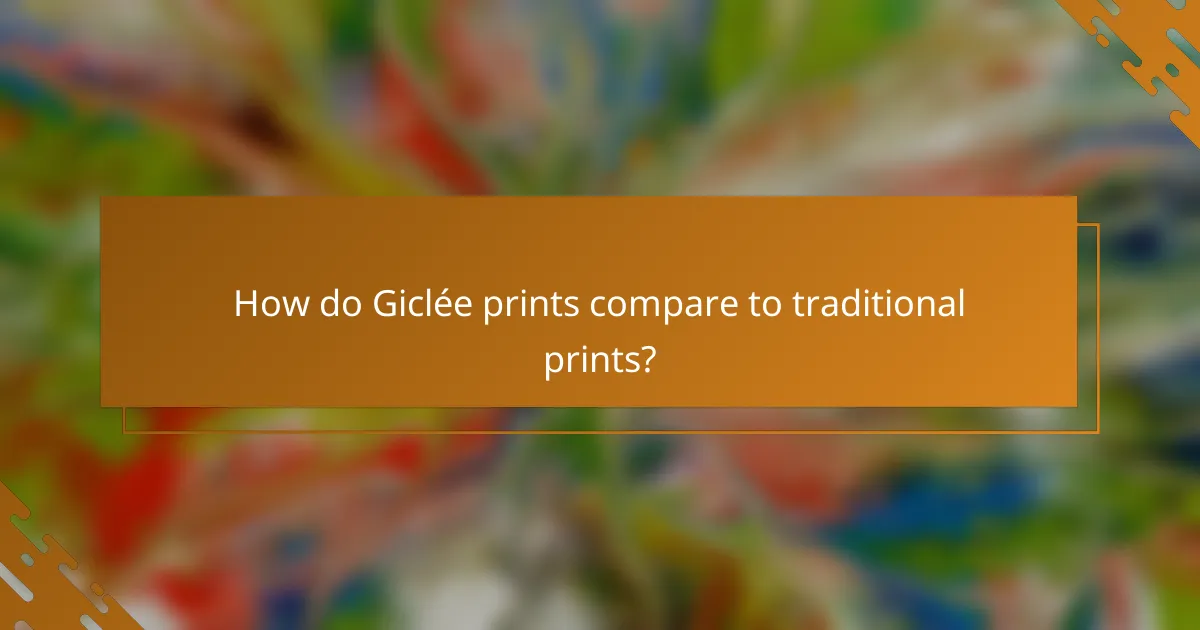
How do Giclée prints compare to traditional prints?
Giclée prints offer superior quality and longevity compared to traditional prints, primarily due to their advanced printing technology. They utilize high-resolution inkjet printers, resulting in more detailed images and vibrant colors that can last for decades without fading.
Higher resolution than offset prints
Giclée prints typically achieve resolutions of 300 DPI (dots per inch) or higher, which is significantly greater than the 150-300 DPI range of offset prints. This higher resolution allows for finer details and smoother gradients, making Giclée prints ideal for reproducing artwork and photographs with intricate designs.
When selecting a printing method, consider that the clarity of Giclée prints can enhance the viewer’s experience, especially in gallery settings or high-end displays. The investment in quality printing can be justified by the visual impact and detail retention over time.
Better color vibrancy
Giclée prints utilize archival-quality inks that provide a wider color gamut compared to traditional inks used in offset printing. This means Giclée prints can reproduce colors more accurately and with greater intensity, resulting in images that appear more lifelike and engaging.
Artists and photographers often prefer Giclée printing for its ability to capture subtle color variations, which is crucial for maintaining the integrity of the original work. The vibrant colors can enhance the overall aesthetic of a piece, making it more appealing to potential buyers.
More environmentally friendly options
Many Giclée printers offer eco-friendly inks and papers, which can significantly reduce the environmental impact of printing. These inks are often water-based and free from harmful chemicals, making them safer for both the environment and indoor air quality.
When choosing Giclée prints, look for options that use sustainable materials, such as recycled paper or organic cotton. This not only supports eco-conscious practices but also appeals to environmentally aware consumers, adding value to the artwork.
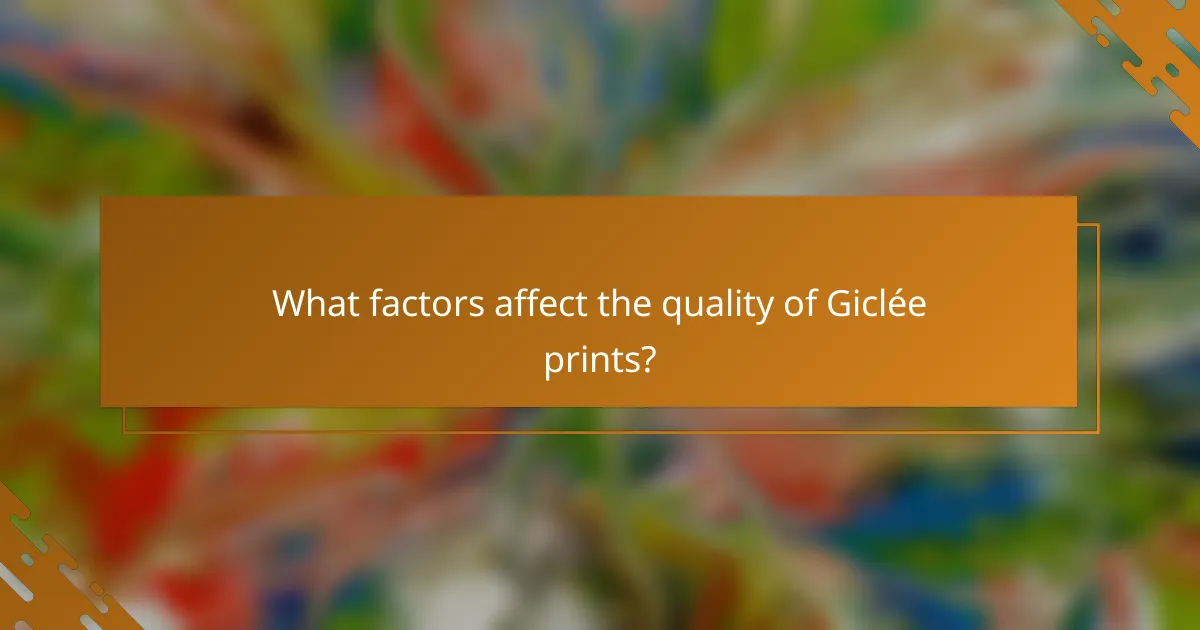
What factors affect the quality of Giclée prints?
The quality of Giclée prints is influenced by several key factors, including the type of printer used, the quality of inks and paper, and the original artwork’s quality. Each of these elements plays a crucial role in determining the final output’s fidelity and longevity.
Type of printer used
The printer type significantly impacts Giclée print quality. Professional-grade inkjet printers, often equipped with multiple color cartridges, produce more accurate color reproduction and finer details compared to standard home printers. Look for printers that support high-resolution printing, typically around 2400 dpi or higher, for optimal results.
When selecting a printer, consider those specifically designed for fine art reproduction. These printers often use pigment-based inks, which offer better longevity and color stability than dye-based inks, making them ideal for Giclée prints.
Quality of inks and paper
The inks and paper used in Giclée printing are critical for achieving high-quality results. Archival-quality inks, which are often pigment-based, provide superior color accuracy and fade resistance, ensuring that prints maintain their vibrancy over time. It’s advisable to choose inks that meet industry standards for longevity, such as those rated for 100 years or more under proper conditions.
Equally important is the choice of paper. Acid-free, archival-grade papers are recommended, as they resist yellowing and deterioration. Common options include fine art paper, canvas, and specialty papers designed for Giclée printing, each offering unique textures and finishes that can enhance the artwork’s presentation.
Artist’s original artwork quality
The quality of the original artwork is fundamental to producing high-quality Giclée prints. High-resolution digital files or well-scanned images of the artwork are essential for capturing the details and colors accurately. Ideally, the original should be created or scanned at a resolution of at least 300 dpi to ensure clarity in the print.
Additionally, the medium used in the original artwork can affect the print’s outcome. Traditional media like oil or watercolor may require careful handling during the scanning process to preserve the nuances of texture and color. Artists should consider the final print’s appearance when creating their original pieces, ensuring they are suitable for reproduction.

What are the best practices for displaying Giclée prints?
To ensure the quality and longevity of Giclée prints, proper display techniques are essential. Following best practices can help preserve the artwork’s vibrancy and prevent damage over time.
Use UV-protective glass
Using UV-protective glass is crucial for displaying Giclée prints, as it blocks harmful ultraviolet rays that can fade colors and degrade materials. This type of glass can reduce UV exposure by up to 99%, significantly extending the life of your artwork.
When selecting frames, look for glass labeled as UV-filtering or museum glass. While these options may be more expensive, the investment is worthwhile for preserving the integrity of your prints.
Keep away from direct sunlight
Direct sunlight can cause irreversible damage to Giclée prints, leading to fading and discoloration. It is advisable to position your artwork away from windows or areas where sunlight directly hits the piece.
If natural light exposure is unavoidable, consider using window treatments such as blinds or UV-filtering films to minimize sunlight impact. This simple step can greatly enhance the longevity of your prints.
Frame with acid-free materials
Framing Giclée prints with acid-free materials is essential to prevent yellowing and deterioration over time. Acidic materials can leach into the artwork, causing irreversible damage.
When framing, choose acid-free mats, backing boards, and adhesives. This practice not only protects the print but also maintains its aesthetic appeal for years to come.
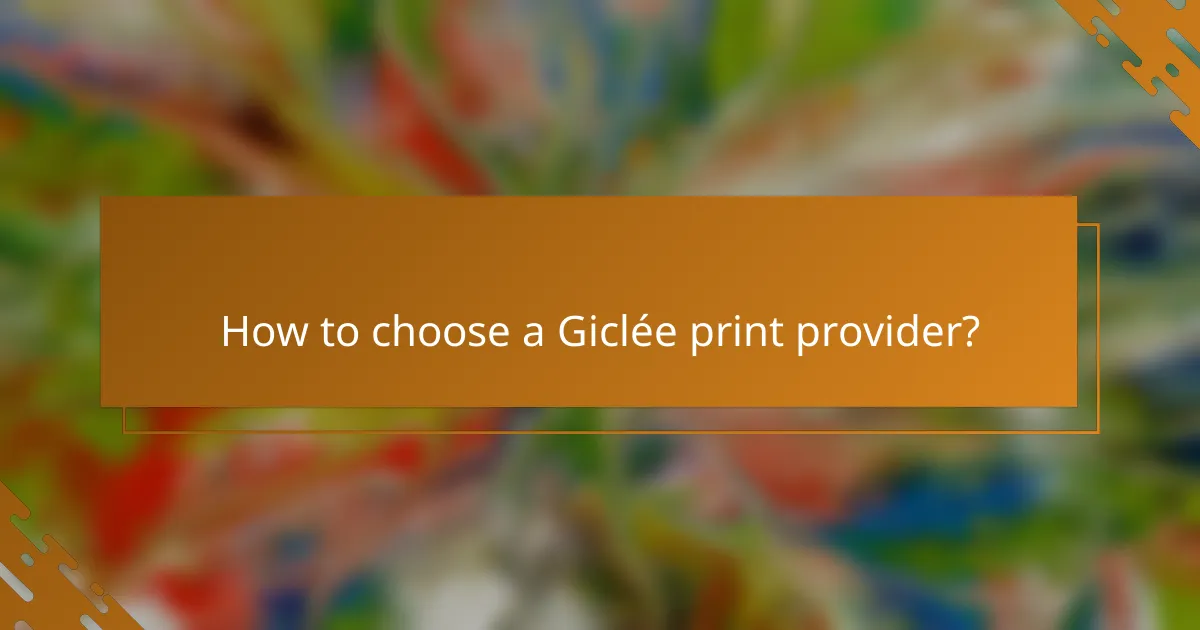
How to choose a Giclée print provider?
Choosing a Giclée print provider involves evaluating their quality, reputation, and the services they offer. Look for providers that specialize in high-quality prints and have a solid track record in the art community.
Check for quality certifications
Quality certifications indicate that a Giclée print provider meets specific industry standards. Look for certifications such as ISO 9001 for quality management or certifications from recognized art organizations that ensure print longevity and color accuracy.
Additionally, inquire about the types of inks and papers used, as archival quality materials are essential for long-lasting prints. Providers should be able to demonstrate their commitment to quality through these certifications.
Read customer reviews
Customer reviews provide insight into the experiences of other artists and buyers with a Giclée print provider. Look for feedback on print quality, customer service, and delivery times to gauge reliability.
Platforms like Google Reviews or art forums can be valuable resources for finding honest opinions. Pay attention to recurring themes in reviews, such as consistent quality or issues with order fulfillment, to make an informed decision.
